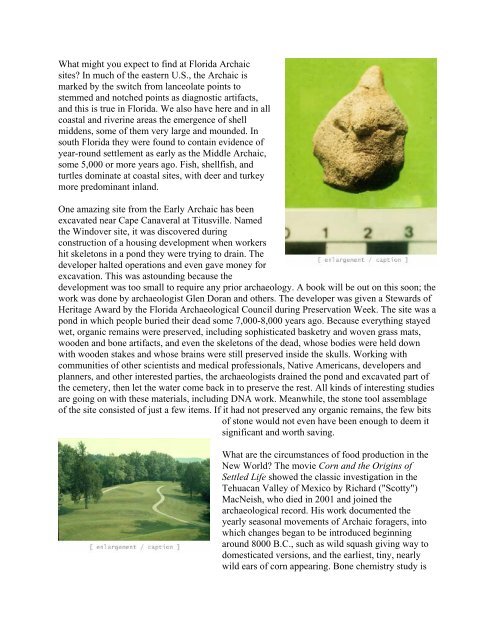INTRODUCTION TO ARCHAEOLOGY Nancy White - Touro Institute
INTRODUCTION TO ARCHAEOLOGY Nancy White - Touro Institute
INTRODUCTION TO ARCHAEOLOGY Nancy White - Touro Institute
Create successful ePaper yourself
Turn your PDF publications into a flip-book with our unique Google optimized e-Paper software.
What might you expect to find at Florida Archaic<br />
sites? In much of the eastern U.S., the Archaic is<br />
marked by the switch from lanceolate points to<br />
stemmed and notched points as diagnostic artifacts,<br />
and this is true in Florida. We also have here and in all<br />
coastal and riverine areas the emergence of shell<br />
middens, some of them very large and mounded. In<br />
south Florida they were found to contain evidence of<br />
year-round settlement as early as the Middle Archaic,<br />
some 5,000 or more years ago. Fish, shellfish, and<br />
turtles dominate at coastal sites, with deer and turkey<br />
more predominant inland.<br />
One amazing site from the Early Archaic has been<br />
excavated near Cape Canaveral at Titusville. Named<br />
the Windover site, it was discovered during<br />
construction of a housing development when workers<br />
hit skeletons in a pond they were trying to drain. The<br />
developer halted operations and even gave money for<br />
excavation. This was astounding because the<br />
development was too small to require any prior archaeology. A book will be out on this soon; the<br />
work was done by archaeologist Glen Doran and others. The developer was given a Stewards of<br />
Heritage Award by the Florida Archaeological Council during Preservation Week. The site was a<br />
pond in which people buried their dead some 7,000-8,000 years ago. Because everything stayed<br />
wet, organic remains were preserved, including sophisticated basketry and woven grass mats,<br />
wooden and bone artifacts, and even the skeletons of the dead, whose bodies were held down<br />
with wooden stakes and whose brains were still preserved inside the skulls. Working with<br />
communities of other scientists and medical professionals, Native Americans, developers and<br />
planners, and other interested parties, the archaeologists drained the pond and excavated part of<br />
the cemetery, then let the water come back in to preserve the rest. All kinds of interesting studies<br />
are going on with these materials, including DNA work. Meanwhile, the stone tool assemblage<br />
of the site consisted of just a few items. If it had not preserved any organic remains, the few bits<br />
of stone would not even have been enough to deem it<br />
significant and worth saving.<br />
What are the circumstances of food production in the<br />
New World? The movie Corn and the Origins of<br />
Settled Life showed the classic investigation in the<br />
Tehuacan Valley of Mexico by Richard ("Scotty")<br />
MacNeish, who died in 2001 and joined the<br />
archaeological record. His work documented the<br />
yearly seasonal movements of Archaic foragers, into<br />
which changes began to be introduced beginning<br />
around 8000 B.C., such as wild squash giving way to<br />
domesticated versions, and the earliest, tiny, nearly<br />
wild ears of corn appearing. Bone chemistry study is
















